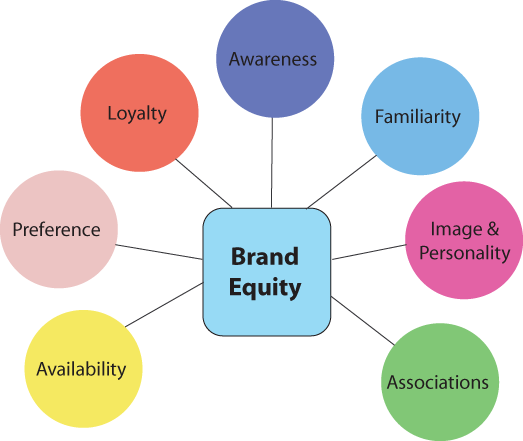Your Brand: Being Online and Brand Equity
30 September 2008 in Modern Business by Kate | Comments
Above is a depiction, provided by Brand Channel of the factors that go into a brand’s equity. I could have inserted any number of images, but the general concepts are the same.
I want to talk about brand equity because I don’t feel there has been enough straight forward conversation about what this means in new and social media. We all know that most brand images are effected by their presence online, but I wonder how much real discussion there is with colleagues and, more importantly, with clients about what this means to the bottom line (sidenote: there are still many spaces that aren’t highly visible online, so, for now, we’re talking about industries for which the Web 2.0 space is highly important).
I’ll use just a few of the above factors as examples:
- Image and Personality: Several months ago, Chris Brogan had a webinar that was called “Who Really Owns Your Brand?” (I discussed it in-depth here). He and the discussants talked about the changes that occur to your brand image in social media: that customers now have more influence over your brand, and that the amount of control a company has over their image is shifting away from them. A company can decide to either enter this space and influence to some extent where their brand is going, or they can remain in a traditional mindset and “push” brand image on customers. We know where that’s headed…..
- Awareness: There are a ton of possible consumer touch points available to companies in the new media space. There are also very attractive opportunities for Word-of-Mouth (WOM). There’s the possibility that customers can bring either positive or negative brand awareness to the table in a high-profile manner. A major way that people become aware of a brand nowadays is online, through friends and in communities. With an increased positive brand awareness comes an increase in brand equity.
- Loyalty: Discussion and conversation with your customers (when done properly) breeds loyalty. I don’t need to beat this one to death. Online is where this is taking place. You wouldn’t want to be left out of the conversation of your own brand would you, or left out of the opportunity to develop a relationship with your customers?
These are just some examples, I could break down all of the above further if I wanted to but I think you get where I’m headed.
The main point is that, while we all know these things, I wonder how many of us directly correlate it to brand equity in the monetary sense, especially with clients. This is important, so let me repeat. New/social media and the Web 2.0 space have important effects on the monetary value of your company.
We recently had a potential client who was wondering what the point was of using new media in his marketing program if they were looking to enter IPO stages in less than five years. The company was absolutely a candidate for new media marketing, and its brand image was already being affected positively and negatively in this space.
My argument to him was (not only that the space is moving incredibly fast and five years could make a huge difference), but, almost more importantly: Your brand image IS online right now, and it IS being affected. And that DOES and WILL matter when determining the value of your company. In some cases, it’s not even a matter of going where it’s hot (although that has its advantages!). Your brand is there, you should be there too.
What’s more, the Web 2.0 world is completely visible to anyone who chooses to look, including potential funders or buyers of your company. That information matters. I’ll not deny that measurement of that value in dollar terms is difficult, but many traditional aspects of brand equity are the same. It still applies.
Most funders and buyers are looking to social media to figure out at least part of the value of brands (and if they’re not, they probably should be, because it’s often one of the best indicators of how consumers feel about your brand). It should be considered right along side of sales figures or profitability.
So I encourage people to talk to clients directly not just about the benefits of new media marketing, but also about the necessity to be in the space from a brand management perspective.
Have you discussed this with clients? Do you consider it important? Is it too vague at this stage to be put into monetary terms? Any thoughts are welcome. Below are a few of Zemanta’s thoughts on the issue, as well as a couple of posts I came across.
Some thoughts from Web Marketing Strategies, Trends and Tips.
Customer Think has some advice.
Related articles by Zemanta
Tags: Brand, Brand Channel, Brand equity, Brand management, Business, Chris Brogan, Marketing, New Media, social media, web 2.0, Word of mouth
-
chelpixie
-
Kate Brodock
-
chelpixie
-
gargouri2001
-
Kate Brodock
Looking for something?
What we’ve been thinking lately
Old Stuff
Advertising/PR
Business
Entrepreneurship/Small Business
Interesting
Marketing
New Media
- &.
- a thousand cuts
- Chris Brogan’s Blog
- Chris Garrett on New Media
- Horse, Pig, Cow
- HubSpot Blog
- iMedia Connection
- Logic + Emotion
- PBS Media Shift
- PR2.0
- Publishing 2.0
- Shannon Paul’s Very Official Blog
- Six Pixels of Separation
- Social Media Explorer
- The Community Roundtable
- Web Strategy by Jeremiah Owyang
- WebInkNow
Technology
Twittering
- Othersidegroup: RT @cmbarnhill: Great article about PR in higher ed - good read for PR people whether you work for a university or not! http://bit.ly/7gPH8z
- Othersidegroup: Cisco: why vlogging is better than blogging (SocialMedia.biz) http://bit.ly/8yq9N3
- Othersidegroup: RT @deakaz: 10 Free eBooks About Social Media http://su.pr/1cYoej [Please RT/Stumble]
- Othersidegroup: Wow, I just resurrected this post on SEO in Layman's terms because my dad asked what it was again! http://bit.ly/4nFzUF
- Othersidegroup: RT @kanter: Colin Delaney has published new e-book How Candidates Can Use the Internet in 2010 to Win http://bit.ly/8VCt13
- Othersidegroup: RT @chrisabraham Why has blogging become so popular with companies? http://bit.ly/6gQIiu




